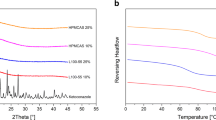Abstract
Differential scanning calorimetry (DSC), Fourier transform infrared spectroscopy, and hot-stage microscopy were employed to evaluate the drug–excipient compatibility of atovaquone with commonly used tablet excipients. The DSC curves of pure drug and excipients were compared with their physical mixtures. Microcrystalline cellulose, titanium dioxide, colloidal silica, ferric oxide, lactose monohydrate, and sodium starch glycolate were compatible, while magnesium stearate, polyethylene glycol (PEG) 8000, Poloxamer 188, and hydroxypropyl methyl cellulose (HPMC) E15 showed incompatibility with the drug. Heat–cool–heat analysis of the physical and the ground mixture of later three excipients showed polymorphic transformation of atovaquone form III to form I, which occurred via amorphization with HPMC E15 and through solubilization mechanism with remaining two excipients. These outcomes were further supported by hot-stage microscopy. Results of milling experiments revealed a milling time-dependent polymorphic transformation and solubilization with HPMC E15 and PEG 8000, respectively. This study highlights the importance of compatibility assessment for selection of excipients in specific unit operations such as milling and grinding.







Similar content being viewed by others
References
Chadha R, Bhandari S. Drug–excipient compatibility screening—role of thermoanalytical and spectroscopic techniques. J Pharm Biomed Anal. 2014;87:82–97.
Magnoni F, Gigliobianco MR, Peregrina DV, Censi R, Di Martino P. Effect of grinding on the solid state stability and particle dissolution of acyclovir polymorphs. J Pharm Sci. 2017;106(10):3084–94.
Pallipurath AR, Civati F, Sibik J, Crowley C, Zeitler JA, McArdle P, et al. A comprehensive spectroscopic study of the polymorphs of diflunisal and their phase transformations. Int J Pharm. 2017;528(1–2):312–21.
Salunke N, Thipparaboina R, Chavan RB, Lodagekar A, Mittapalli S, Nangia A, et al. Rufinamide: crystal structure elucidation and solid state characterization. J Pharm Biomed Anal. 2018;149:185–92. https://doi.org/10.1016/j.jpba.2017.11.003.
Kaur A, Goindi S, Katare OP. Thermal analysis and quantitative characterization of compatibility between diflunisal and lipid excipients as raw materials for development of solid lipid nanoparticles. Thermochim Acta. 2016;643:23–32.
Bruni G, Amici L, Berbenni V, Marini A, Orlandi A. Drug–excipient compatibility studies. Search of interaction indicators. J Therm Anal Calorim. 2002;68(2):561–73.
Pires S, Mussel W, Yoshida M. Solid-state characterization and pharmaceutical compatibility between citalopram and excipients using thermal and non-thermal techniques. J Therm Anal Calorim. 2017;127(1):535–42.
Rojek B, Wesolowski M. Compatibility studies of hydrocortisone with excipients using thermogravimetric analysis supported by multivariate statistical analysis. J Therm Anal Calorim. 2017;127(1):543–53.
Teleginski LK, Maciel AB, Mendes C, Silva MAS, Bernardi LS, de Oliveira PR. Fluconazole–excipient compatibility studies as the first step in the development of a formulation candidate for biowaiver. J Therm Anal Calorim. 2015;120(1):771–81.
Gao R, Jin Y, Yang Q-Y, Sun B-W, Lin J. Study of stability and drug–excipient compatibility of estradiol and pharmaceutical excipients. J Therm Anal Calorim. 2015;120(1):839–45.
Pani NR, Nath LK, Acharya S, Bhuniya B. Application of DSC, IST, and FTIR study in the compatibility testing of nateglinide with different pharmaceutical excipients. J Therm Anal Calorim. 2011;108(1):219–26.
Chaves LL, Rolim LA, Gonçalves ML, Vieira AC, Alves LD, Soares MF, et al. Study of stability and drug–excipient compatibility of diethylcarbamazine citrate. J Therm Anal Calorim. 2013;111(3):2179–86.
Ghaderi F, Nemati M, Siahi-Shadbad MR, Valizadeh H, Monajjemzadeh F. Thermal stability and kinetic study of fluvoxamine stability in binary samples with lactose. Adv Pharm Bull. 2017;7(1):43.
Mura P, Faucci M, Manderioli A, Bramanti G, Ceccarelli L. Compatibility study between ibuproxam and pharmaceutical excipients using differential scanning calorimetry, hot-stage microscopy and scanning electron microscopy. J Pharm Biomed Anal. 1998;18(1):151–63.
Shantikumar S, Sreekanth G, SurendraNath K, JaferValli S, Satheeshkumar N. Compatibility study between sitagliptin and pharmaceutical excipients used in solid dosage forms. J Therm Anal Calorim. 2014;115(3):2423–8.
Hudson A. Atovaquone—a novel broad-spectrum anti-infective drug. Parasitol Today. 1993;9(2):66–8.
Malpezzi L, Fuganti C, Maccaroni E, Masciocchi N, Nardi A. Thermal and structural characterization of two polymorphs of Atovaquone and of its chloro derivative. J Therm Anal Calorim. 2010;102(1):203–10.
Ceolin R, Rietveld IB. Phenomenology of polymorphism and topological pressure–temperature diagrams. J Therm Anal Calorim. 2010;102(1):357–60.
Desai S, Shaikh M, Dharwadkar S. Thermoanalytical study of polymorphic transformation in fluconazole drug. Thermochim Acta. 2003;399(1):81–9.
Acknowledgements
The authors acknowledge the financial support from the Department of Pharmaceuticals (DoP), Ministry of Chemicals and Fertilizers, Govt. of India. Prof. Ashwini Nangia, School of Chemistry, University of Hyderabad, is acknowledged for his support with the PXRD analysis.
Author information
Authors and Affiliations
Corresponding author
Ethics declarations
Conflict of interest
The authors report no conflict of interest.
Electronic supplementary material
Below is the link to the electronic supplementary material.
Rights and permissions
About this article
Cite this article
Chavan, R.B., Shastri, N.R. Polymorphic transformation as a result of atovaquone incompatibility with selected excipients. J Therm Anal Calorim 131, 2129–2139 (2018). https://doi.org/10.1007/s10973-017-6860-9
Received:
Accepted:
Published:
Issue Date:
DOI: https://doi.org/10.1007/s10973-017-6860-9




